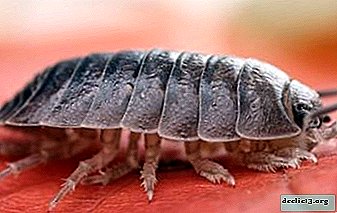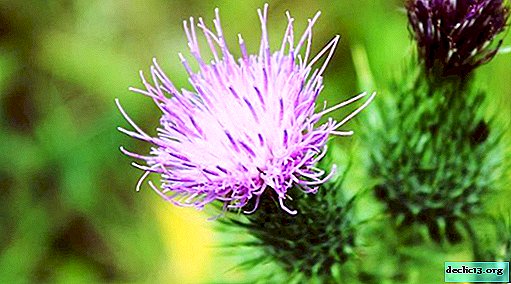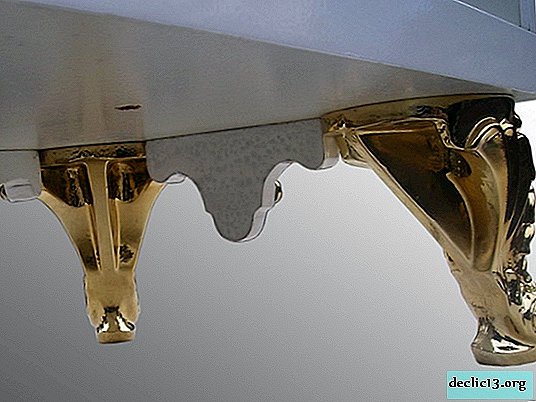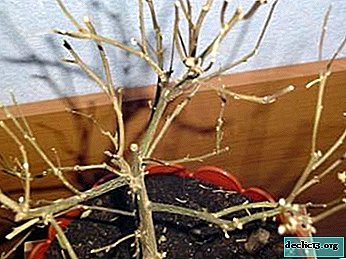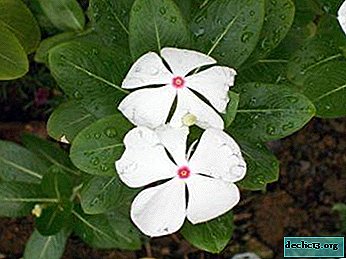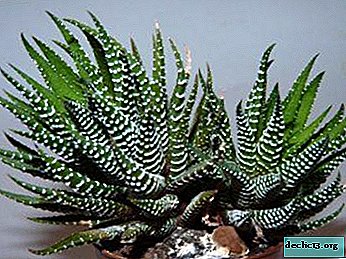Description and photo varieties of climbing roses Sympathy. Features of growing and rules for flower care

Climbing roses are frequent visitors to flower beds. And this is not surprising, since the plant is striking in its beauty and splendor.
But not all species are unpretentious to the conditions of detention and care. One of the most popular types of climbing roses is Sympathy.
This plant has the appearance of a tall bush with large bright scarlet double flowers. In our article, you can see it in the photo and find out a lot of useful information about caring for this magnificent plant.
Description of appearance
The climbing sympathy has large red flowers, the diameter of which is 10 cm. The inflorescences consist of numerous flowers, in one brush there are 3-10 of them, and in one bud there are 19-21 petals. Feature of the variety in a strong floral aroma. Flowers do not spoil the rain, they endure all weather changes, they take root well in any region of Russia. The bushes themselves are branched, while powerful and hardy. They are not afraid of low temperatures and withstand strong winds. Bushes resist the main diseases of roses.
Photo
Below you can see a photo of the plant:





History of occurrence
The original name of the variety is Sympathie (Sympathy), it was bred by German breeder Wilhelm Cordes in 1964. In the international classification, the rose is assigned to the Kleimbers. Since that time, the variety began to be in great demand in all countries of Europe.
Difference from other species
Rosa Sympathy differs from other varieties in the following ways:
- a powerful bush that needs reliable support, since the height is 2 times the width;
- flowering can last until frost;
- the rose is resistant to major diseases above average;
- firmly resists waterlogging in the form of prolonged rainfall.
Bloom
- When and how?
Rose of Sympathy blooms for a long time. The buds open in early June, at which time they are present in large numbers. After a month, their number decreases, and in late September-early October, flowering stops. During flowering, the bush is literally showered with bright red roses, which emit a pleasant aroma.
- Care before and after flowering.
During flowering, the plant must be fed with potassium-phosphorus compounds. They affect the quantity and quality of flowering, and also on the preparation of young shoots for winter frosts.
All faded buds must be removed before the fruit is formed. This will prolong flowering, while the buds will remain large and will not fade. - What to do if it does not bloom?
The lack of flowering occurs for the following reasons:
- Poor soil quality. Do not plant a plant in heavy and dense soil. To make the composition easier, you need to add a little sand to it.
- Lack of or excess fertilizer. If you overdo it with nitrogen compounds, then leaves and shoots will actively grow, and there will be no flowering. Phosphate-potassium preparations will help to correct the situation.
- Pruning. You need to spend it every spring. It rejuvenates the bush and activates its flowering.
Step-by-step care instructions
 Choosing a landing place.
Choosing a landing place.The climbing rose Sympathy loves to grow in a well-lit and sunny area. It is best to plant a plant on the south side of the site.
- What should be the soil?
A rose is grown on breathable loam. Soil should have slightly acidic properties. There must be a sufficient amount of minerals in the ground.
- Landing.
Landing measures are carried out as follows:
- Place drainage at the bottom of the landing pit using gravel or sand.
- 5 hours before planting, lower the seedling into a container of water.
- Shorten shoots to 20 cm, remove weak, leave only medium and strong.
- Add 5 l of water to each planting pit, and when it is absorbed, plant a plant.
- Carefully spread its roots and sprinkle with earth, filling all the voids.
- Between the bushes, observe a distance of 45-50 cm.
- Temperature.
In summer, the optimum temperature for a rose is 22-24 degrees, so you need to choose a place for it where there are no scorching sunlight in the daytime. In autumn, the flower is able to withstand a temperature of -5 degrees, and then you need to carry out the shelter of the plant.
- Watering.
Humidify the rose with standing water 1-2 times in 2 weeks. Under each bush you need to pour 20-30 liters of water. It is better to carry out this procedure in the morning. After watering, lay a layer of mulch. For these purposes, manure composted with soil is used. Put rotted manure along the perimeter of the bushes, backing 2-3 cm from the stems. After this, the soil is loosened to a depth of 1-2 cm.
- Top dressing.
The first 2 years after planting a plant in the ground, you can not make food. For 3-1 years, you can make nitroammophoska or manure. Over the entire period of the growing season, fertilize 2-3 times. For top dressing on leaves and stems, the solution is diluted weaker than when watering. Then, using a broom soaked in a solution, spray the composition on foliage and stems. Before such a procedure, the plant should be properly watered.
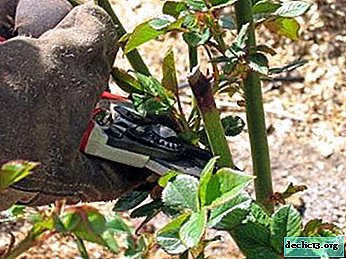 Pruning.
Pruning.In spring, broken and weakened branches are pruned. As soon as autumn arrives, already faded branches are subject to removal. This will stimulate the growth of new shoots that will rejuvenate the bush.
Young shoots in the first and second year after planting need to be formed. To do this, leave 5-7 skeletal wicker, and the rest cut off. After 4-5 years, it is necessary to replace the old skeletal branches with younger ones. Thus, in 4-5 years, you need to choose the strongest lashes, leave them, and cut off the old ones. It is necessary to replace 1 old lash per year.
- How to tie a plant.
Procedure:
- Install the support immediately after planting seedlings so as not to damage the overgrown root system after.
- To direct the stems horizontally on the trellis, then the process of bud formation will be active.
- You can fix the whip of roses with a thin wire.
- Transfer.
Transplanting a climbing rose must be carried out in the spring, as soon as the ground thaws from winter frosts, and the buds on the branches are not yet awake.
Procedure:
- The aerial part of the plant is carefully removed from the support, and dug up the bush, moving from its base with an indent of 50-60 cm.
- Extract the plant from the soil, remove excess soil from the roots.
- In the already prepared landing pit, install a bush, straighten the roots and point them down.
- The empty space in the pit needs to be filled with soil composition, lightly tamped and water well.
- After 3-4 days, you need to add soil, spud the bush.
- Preparation for winter.
In August, it is necessary to complete the last watering, to loosen the soil and to top dress. You need to cover the bushes after the air temperature drops to -5 degrees. The plant needs to be removed from its supports, cut sick and broken branches. After this, the lashes are tied with a rope and pressed to the ground with metal or wooden hooks. At the end, fallen leaves or fir spruce are placed on the whip.
How to propagate?
 Cuttings.
Cuttings.Procedure:
- In winter, cut the cuttings from the bush. One plant should have 4-5 buds.
- From the bottom of the stem, cut off all the leaves.
- Plant cuttings in a container with nutrient soil obtained from sand and garden soil (1: 1).
- Cover each stalk with a glass jar and set in a dark place.
- Sprouts need to be watered and fed.
- On open ground, the plant can be planted in early June. In a year, buds will appear on the bushes.
- Layering.
To propagate the rose in this way, the whip from the bush is pressed to the soil, spud, watered, and as soon as the roots appear, the plant is cut from the whip and transplanted. Thanks to this method of propagation, the lash quickly takes root, and the formed bush takes root well in the plot.
Diseases and Pests
This type of rose can be affected by the following diseases:
- Powdery mildew.
It can be recognized by the presence of white spots, which increase over time in size. Helps to multiply the fungus hot and humid weather. Due to the defeat, the plant stops growing and slowly dies. To prevent the disease, you need to treat the bush with a solution of Bordeaux fluid. The first time the procedure is carried out before the buds open, and the second after removing the shelter. The final spraying of the rose should be carried out when the length of the young shoots reaches 20 cm.
- Kinoiorium (burn).
This disease occurs imperceptibly, as they discover it after removing the shelter. At the first stage of development, brown spots with a red tint are formed on the cortex. Over time, they grow and change their color to black. It is difficult to defeat this ailment, since the fungus is inside the tissues.
To save the plant, you need to cut off all the affected branches, capturing a slightly healthy part, it is necessary to burn the cut off parts. For prevention, in the fall, roses are fed with potash fertilizers.
Of the pests, the danger to the roses is:
- Thrips. These are small insects with a pale yellow color. For the fight, drugs such as Karbofos, Intavir, Fufanon are used.
- Spider mite. He joins the inside of the foliage, drinking juice from it. For control, infusion of yarrow, wormwood or shag (40 g of raw material per 1 liter of water) is used.
Climbing rose Sympathy - a bright and fragrant plant that is used to decorate various hedges, flower beds. You need to take care of the rose thoroughly, otherwise it will hurt, and there will be no flowering.

 Choosing a landing place.
Choosing a landing place. Pruning.
Pruning. Cuttings.
Cuttings.